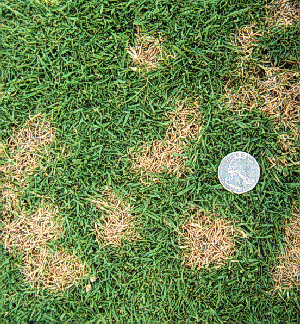Source(s): Laurene Hall
Dollar Spot makes circular areas only a few inches in diameter. Spots may run together causing large, irregular patterns. Blades have straw-colored lesions along one edge that spread across the leaf blade until tips dieback. Leading edge of dieback is reddish brown. White mycelium (the vegetative part of a fungus that looks like a mass of branching strings) may be associated with patches when turf is wet.
Appearance
Active in late spring to late autumn. Will attack lush turf fertilized with excessive nitrogen (<1/2 lb. N/1000 sq. ft./month). Disease is severe in soils that are low in phosphorus and potash; when night temperatures are 50 to 60° F (10 – 16° C) and when more than 10 hours of foliar wetness persists per day for several days. Disease is also severe when the soil drains poorly and turf has previously suffered from other environmental stresses
Hosts
Bentgrass, Bermuda, Centipede, Fescue, Rye, St. Augustine, Zoysia
IPM Control
Maintain adequate nitrogen fertility. 1/2 lb. to 1 lb. of N/1000 sq. ft. every 2 – 4 weeks will reduce severity of disease. Maintain moderate to high levels of soil potassium as determined by soil tests. Decrease shade and increase air circulation to enhance drying of turf. Avoid irrigation in late afternoon and in evening prior to midnight. Water only when required to depth of 5 – 7 inches in early morning. Maintain thatch at ½ in. thickness or less. Raise mowing height.
Chemical Controls
If you think you have Dollar Spot in your lawn, bring a sample of grass (about 4 in. square) with both living and dead tissue to the Extension office for proper diagnosis. A fungicide recommendation may be required if the problem cannot be corrected by cultural IPM practices. Always carefully follow label directions when applying chemicals and wear protective clothing if necessary
Resource(s):
Center Publication Number: 46
- Leaf Spots - September 24, 2013
- Needle Blight - September 24, 2013
- Dollar Spot - September 23, 2013

